In today’s fast-paced world, finding moments of tranquility within the confines of our homes has become increasingly important. Indoor plants not only enhance the aesthetics of our living spaces but also improve air quality and contribute to our overall well-being. However, not all homes are blessed with ample natural light. If you have low-light areas in your home and still want to enjoy the beauty of indoor trees, you’re in luck! In this article, we’ll explore the best indoor trees that thrive in low-light conditions.
Understanding Low-Light Conditions
Low-light areas typically receive little to no direct sunlight. These spaces can be found in rooms with small windows, north-facing rooms, or areas that are obstructed by nearby buildings or trees. Choosing indoor trees that can thrive in such conditions is crucial for their health and longevity.
Benefits of Indoor Trees
Before we dive into our list of low-light indoor trees, let’s briefly discuss the benefits they bring to your home. Indoor trees not only add a touch of nature to your decor but also offer the following advantages:
- Improved Air Quality: Many indoor trees act as natural air purifiers, removing toxins and pollutants from the air.
- Stress Reduction: The presence of greenery has been shown to reduce stress and promote a sense of well-being.
- Aesthetic Appeal: Indoor trees add beauty and elegance to your home’s interior, creating a more inviting atmosphere.
Now, let’s explore the best indoor trees for low-light conditions:
Peace Lily (Spathiphyllum)
Peace lilies are renowned for their graceful white blooms and their ability to thrive in low-light environments. They are excellent air purifiers and can remove common indoor pollutants like formaldehyde and benzene.
Snake Plant (Sansevieria)
Also known as the “Mother-in-law’s tongue,” snake plants are hardy and can tolerate low light. They have striking upright leaves and are known for their air-purifying qualities.
ZZ Plant (Zamioculcas Zamiifolia)
ZZ plants are known for their resilience and adaptability. They can thrive in low light and are incredibly low-maintenance, making them perfect for beginners.
Rubber Plant (Ficus Elastica)
Rubber plants have dark, glossy leaves and can tolerate low light conditions. They grow slowly and can become a stunning focal point in any room.
Parlor Palm (Chamaedorea Elegans)
Parlor palms are well-suited for low-light areas and can bring a tropical touch to your home. They have delicate fronds and are relatively easy to care for.
Dracaena Marginata
With its slender, arching leaves, the Dracaena Marginata adds an exotic flair to your home. It can adapt to low-light settings but benefits from occasional bright light exposure.
Fiddle Leaf Fig (Ficus Lyrata)
Fiddle leaf figs are prized for their large, violin-shaped leaves. While they prefer bright, indirect light, they can tolerate low light conditions if necessary.
Pothos (Epipremnum Aureum)
Pothos is one of the most versatile indoor plants and can thrive in low to moderate light. Their trailing vines add a touch of elegance to any space.
Chinese Evergreen (Aglaonema)
Chinese evergreens come in various colorful varieties and are known for their adaptability to low-light conditions. They are excellent for purifying the air.
Cast Iron Plant (Aspidistra Elatior)
As the name suggests, cast iron plants are incredibly hardy and can withstand low light and neglect. Their deep green leaves add a classic touch to your decor.
Spider Plant (Chlorophytum Comosum)
Spider plants are known for their air-purifying qualities and arching green and white striped leaves. They thrive in low to moderate light conditions.
Bamboo Palm (Chamaedorea Seifrizii)
Bamboo palms are excellent for adding a tropical vibe to your home. They can adapt to low light, but some indirect sunlight is ideal for their growth.
Money Tree (Pachira Aquatica)
Money trees are said to bring good luck and prosperity. They can tolerate low light but do best with occasional exposure to indirect sunlight.
Conclusion
Adding indoor trees to your low-light spaces is an excellent way to enhance your home’s ambiance while reaping the numerous benefits they offer. Whether you choose the elegant Peace Lily, the resilient Snake Plant, or any other tree from our list, you’ll enjoy the beauty of greenery in every corner of your home.

FAQs
- Can indoor trees really survive in low-light conditions?
- Yes, many indoor trees are well-suited for low-light environments and can thrive with proper care.
- How often should I water my indoor trees in low-light areas?
- It’s essential to let the soil dry slightly between waterings to avoid overwatering. Check the specific care instructions for your chosen tree.
- Do indoor trees require fertilizer in low-light conditions?
- Indoor trees do benefit from occasional fertilization, but use a diluted, balanced liquid fertilizer and follow the recommended schedule.
- Can I place indoor trees in completely dark corners of my home?
- While some indoor trees can tolerate low light, it’s best to provide them with some indirect or filtered sunlight periodically.
- Are there any indoor trees that flower in low-light conditions?
- Yes, Peace Lilies are known for their beautiful white blooms and can thrive in low light.
Now that you have a better understanding of the best indoor trees for low-light conditions, it’s time to bring some greenery into your home. Get started and transform your living spaces into serene sanctuaries of nature.



